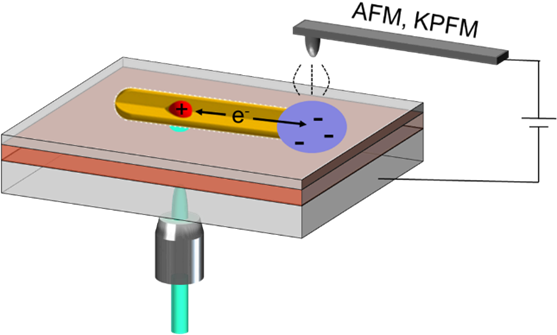Research Area A
Isolated Anisotropic Hybrid Nanostructures Composed of Semiconductor and/or Metal Components
In this area anisotropic hybrid materials will be produced and investigated. The focus is on semiconductor, metal, and semiconductor/metal nanostructures, which are produced and coupled in a defined form with chemical methods, to investigate them with spectroscopic methods and to model them with theoretical methods.
Anisotropic semiconductor hetero-nanostructures
Heterogeneous semiconductor nanorods, which consist of a nanorod with an integrated spherical nanocrystal, so-called dot-rod nanostructures (DRs), are to be fabricated in different combinations of materials, depending on the band gaps, as type I or type II heterostructures. Based in this, double-dot-rod structures (DDRs) are to be produced and investigated, in which two nanocrystals are integrated into a nanorod, whereby synthesis routes are to be developed in order to set both the distance and the material of the two nanocrystals within a nanorod. The physical properties of the nanorods, e.g. resulting from directed electron or energy transfer processes within the heterostructures, will investigated using various spectroscopic methods such as (transient) absorption or (time-resolved) fluorescence measurements under the influence of electric fields. These investigations are to be supported by atomistic calculations in order to trace the macroscopic effects back to basic quantum mechanical findings.

Anisotropic metal hetero-nanostructures
Anisotropic metal structures shall be prepared via new synthetic strategies, e.g. by using proteins as biological ligands. The particles produced in this way will serve as nuclei for the growth of heterogeneous, anisotropic metal nanostructures made of different materials, e.g. by growing beads of another material at the tips of rods of one material. In addition, ion exchange reactions will be used to produce heterogeneous structures and alloys.

The plasmonic (optical) and electronic properties of such hybrids are to be investigated by spectroscopic methods and described by theoretical models, whereby for structural investigations also modern X-ray methods or high-resolution electron microscopy should be used.
Anisotropic semiconductor-metal hybrid nanostructures
Anisotropic structures of metal and semiconductor components with and without insulating spacers between the two components are to be produced and investigated. For semiconductor structures with directly attached metal components, photoinduced charge transfer processes will be investigated in microscopic fluorescence or Kelvin probe experiments on individual hybrids. These experiments will also provide the basis for the experiments planned in research area B on corresponding assemblies. Here also magnetizable metal particles are to be connected to the semiconductor nanorods in order to control the assembly in research area B via external magnetic fields. For hybrid systems in which the metal components are applied to semiconductor rods via insulating spacers, energy transfer processes and plasmon exciton coupling mechanisms within the hybrid will be investigated.


